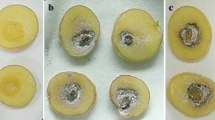Abstract
Multi-locus sequence analysis has been demonstrated to be a useful tool for identification of Streptomyces species and was previously applied to phylogenetically differentiate the type strains of species pathogenic on potatoes (Solanum tuberosum L.). The ARS Culture Collection (NRRL) contains 43 strains identified as Streptomyces scabiei deposited at various times since the 1950s and these were subjected to multi-locus sequence analysis utilising partial sequences of the house-keeping genes atpD, gyrB, recA, rpoB and trpB. Phylogenetic analyses confirmed the identity of 17 of these strains as Streptomyces scabiei, 9 of the strains as the potato-pathogenic species Streptomyces europaeiscabiei and 6 strains as potentially new phytopathogenic species. Of the 16 other strains, 12 were identified as members of previously described non-pathogenic Streptomyces species while the remaining 4 strains may represent heretofore unrecognised non-pathogenic species. This study demonstrated the value of this technique for the relatively rapid, simple and sensitive molecular identification of Streptomyces strains held in culture collections.


Similar content being viewed by others
References
Barka EA, Vatsa P, Sanchez L, Gaveau-Vaillant N, Jacquard C, Klenk H-P, Clément C, Ouhdouch Y, van Wezel GP (2016) Taxonomy, physiology, and natural products of Actinobacteria. Microbiol Mol Biol Rev 80:1–43
Bouchek-Mechiche K, Gardan L, Normand P, Jouan B (2000) DNA relatedness among strains of Streptomyces pathogenic to potato in France: description of three new species, S. europaeiscabiei sp. nov. and S. stelliscabiei sp. nov. associated with common scab, and S. reticuliscabiei sp. nov. associated with netted scab. Int J Syst Evol Microbiol 50:91–99
Burkhalid RA, Chung SY, Loria R (1998) nec1, a gene conferring a necrogenic pheonotipe, is conserved in plant-pathogenic Streptomyces species and lined to a transposase pseudogene. Mol Plant-Microbe Interact 11:960–967
Darriba D, Taboada GL, Doallo R, Posada D (2012) jModelTest 2: more models, new heuristics and parallel computing. Nat Methods 9:772
Felsenstein J (1985) Confidence limits on phylogenies: an approach using the bootstrap. Evolution 39:783–791
Guindon S, Gascuel O (2003) A simple, fast and accurate method to estimate large phylogenies by maximum-likelihood. Syst Biol 52:696–704
Jolley K, Maiden M (2010) BIGSdb: scalable analysis of bacterial genome variation at the population level. BMC Bioinform 11:595
Kämpfer P, Glaeser SP, Parkes L, van Keulen G, Dyson P (2015) The Family Streptomycetaceae. In: Rosenberg E, DeLong EF, Lory S, Stackebrandt E, Thompson F (eds) The Prokaryotes, actinobacteria, 4th edn. Springer, Berlin, pp 889–1010
Katoh K, Standley DM (2013) MAFFT multiple sequence alignment software version 7: improvements in performance and usability. Mol Biol Evol 30:772–780
Kimura M (1980) A simple method for estimating evolutionary rate of base substitutions through comparative studies of nucleotide sequences. J Mol Evol 16:111–120
Labeda DP (2011) Multi-locus sequence analysis of phytopathogenic species of the genus Streptomyces. Int J Syst Evol Microbiol 61:2525–2531
Labeda DP, Doroghazi JP, Ju K-S, Metcalf WW (2014) Taxonomic evaluation of Streptomyces albus and related species using multi-locus sequence analysis and proposals to emend the description of Streptomyces albus and describe Streptomyces pathocidini sp. nov. Int J Syst Evol Microbiol 64:894–900
Lambert DH, Loria R (1989a) Streptomyces scabies sp. nov., nom. rev. Int J Syst Bacteriol 39:387–392
Lambert DH, Loria R (1989b) Streptomyces acidiscabies sp. nov. Int J Syst Bacteriol 39:393–396
Miyajima K, Tanaka F, Takeuchi T, Kuninaga S (2008) Streptomyces turgidiscabies sp. nov. Int J Syst Bacteriol 48:495–502
Nei M, Kumar S (2000) Molecular evolution and phylogenetics. Oxford University Press, New York
Park DH, Kim JS, Kwon SW, Wilson C, YuYM HurJH, Lim CK (2003) Streptomyces luridiscabiei sp. nov., Streptomyces puniciscabiei sp. nov. and Streptomyces niveiscabiei sp. nov., which cause potato common scab disease in Korea. Int J Syst Evol Microbiol 53:2049–2054
Rong X, Huang Y (2012) Taxonomic evaluation of the Streptomyces hygroscopicus clade using multi-locus sequence analysis and DNA–DNA hybridization, validating the MLSA scheme for the systematics of the whole genus. Syst Appl Microbiol 35:7–18
Saitou N, Nei M (1987) Theneighbor-joining method: a new method for reconstructing phylogenetic trees. Mol Biol Evol 4:406–425
Shirling E, Gottlieb DA (1966) Methods for characterization of Streptomyces species. Int J Syst Bacteriol 16:313–340
Tamura K, Nei M (1993) Estimation of the number of nucleotide substitutions in the control region of mitochondrial DNA in humans and chimpanzees. Mol Biol Evol 10:512–526
Tamura K, Stecher G, Peterson D, Filipski A, Kumar S (2013) MEGA6: molecular Evolutionary Genetics Analysis version 6.0. Mol Biol Evol 30:2725–2729
Acknowledgments
The able technical assistance of E. Basehoar in determining the house keeping gene sequences and A. McGovern in producing draft genome sequences is gratefully acknowledged. Mention of trade names or commercial products in this publication is solely for the purpose of providing specific information and does not imply recommendation or endorsement by the U.S. Department of Agriculture. USDA is an equal opportunity provider and employer. DPL and the ARS Culture Collection CRIS project was supported by ARS National Program 301.
Author information
Authors and Affiliations
Corresponding author
Electronic supplementary material
Below is the link to the electronic supplementary material.
Rights and permissions
About this article
Cite this article
Labeda, D.P. Taxonomic evaluation of putative Streptomyces scabiei strains held in the ARS Culture Collection (NRRL) using multi-locus sequence analysis. Antonie van Leeuwenhoek 109, 349–356 (2016). https://doi.org/10.1007/s10482-015-0637-6
Received:
Accepted:
Published:
Issue Date:
DOI: https://doi.org/10.1007/s10482-015-0637-6




